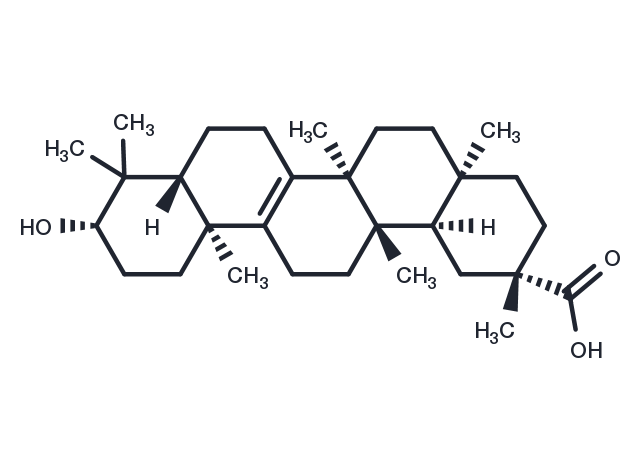keep away from direct sunlight,keep away from moisture,store at low temperature
Powder: -20°C for 3 years | In solvent: -80°C for 1 year

Bryonolic acid (20-epi-Bryonolic acid), a triterpenoid extracted from Sandoricum indicum, possesses immunomodulatory, anti-inflammatory, antioxidant and anticancer activities and protects PC12 cells from NMDA-induced apoptosis by inhibiting Ca2+ in-flux and modulating gene expression in the Ca2+-CaMKII-CREB signalling pathway.

| Pack Size | Availability | Price/USD | Quantity |
|---|---|---|---|
| 5 mg | Inquiry | $ 769.00 |

| Description | Bryonolic acid (20-epi-Bryonolic acid), a triterpenoid extracted from Sandoricum indicum, possesses immunomodulatory, anti-inflammatory, antioxidant and anticancer activities and protects PC12 cells from NMDA-induced apoptosis by inhibiting Ca2+ in-flux and modulating gene expression in the Ca2+-CaMKII-CREB signalling pathway. |
| Targets&IC50 | M1 mAChR:7.08 (pKi), M3 mAChR:6.70 (pKi), mAChR4:7.00 (pKi), H1 Receptor:7.48 (pA2), M2 mAChR:7.78 (pKi) |
| In vitro |
In the presence of three elicitors (methyl jasmonate, yeast extract, and chitosan), cell suspensions treated with 1 mg/mL of chitosan for eight days led to higher bryonolic acid contents (23.56 ± 1.68 mg/g dry weight),cell culture and root extracts with high bryonolic acid contents resulted in significantly higher percent cell viabilities than those observed under control (1% v/v DMSO) treatment in Saos-2 and MCF-7 cells[1]. Bryonolic acid inhibits ACAT in intact cancer cells with an IC50 of 12.6 ± 2.4 µM.Bryonolic acid inhibited both clonogenicity and invasiveness of several cancer cell lines[2]. |
| In vivo | Treatment with 500 mg/kg Bryonolic acid or vehicle by intraperitoneal injection in Nrf2 wild-type or Nrf2 knockout mice revealed that Bryonolic acid effectively induced HO-1 in a manner dependent on the Nrf2-Keap1 pathway[3]. |
| Synonyms | UNII-J7YR6A878I, 20-epi-Bryonolic acid |
| Molecular Weight | 456.7 |
| Formula | C30H48O3 |
| CAS No. | 24480-45-3 |
keep away from direct sunlight,keep away from moisture,store at low temperature
Powder: -20°C for 3 years | In solvent: -80°C for 1 year
DMSO: 1 mg/mL (2.19 mM), Sonication is recommended.
You can also refer to dose conversion for different animals. More
bottom
Please see Inhibitor Handling Instructions for more frequently ask questions. Topics include: how to prepare stock solutions, how to store products, and cautions on cell-based assays & animal experiments, etc.
Bryonolic acid 24480-45-3 Apoptosis Membrane transporter/Ion channel Metabolism oxidation-reduction Calcium Channel Antioxidant UNII-J7YR6A878I 20-epi-Bryonolic acid inhibitor inhibit
